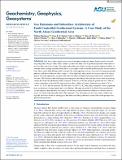Files in this item
Gas emissions and subsurface architecture of fault-controlled geothermal systems : a case study of the North Abaya geothermal area
Item metadata
| dc.contributor.author | Hutchison, William | |
| dc.contributor.author | Ogilvie, Euan | |
| dc.contributor.author | Birhane, Yafet G. | |
| dc.contributor.author | Barry, Peter | |
| dc.contributor.author | Fischer, Tobias P. | |
| dc.contributor.author | Ballentine, Chris J. | |
| dc.contributor.author | Hillegonds, Darren J. | |
| dc.contributor.author | Biggs, Juliet | |
| dc.contributor.author | Albino, Fabien | |
| dc.contributor.author | Cervantes, Chelsea | |
| dc.contributor.author | Gübrandsson, Snorri | |
| dc.date.accessioned | 2023-03-31T09:30:03Z | |
| dc.date.available | 2023-03-31T09:30:03Z | |
| dc.date.issued | 2023-04-01 | |
| dc.identifier | 283776307 | |
| dc.identifier | a275594c-adc8-42ac-9741-381c9e6b4ce2 | |
| dc.identifier | 85153700631 | |
| dc.identifier.citation | Hutchison , W , Ogilvie , E , Birhane , Y G , Barry , P , Fischer , T P , Ballentine , C J , Hillegonds , D J , Biggs , J , Albino , F , Cervantes , C & Gübrandsson , S 2023 , ' Gas emissions and subsurface architecture of fault-controlled geothermal systems : a case study of the North Abaya geothermal area ' , Geochemistry, Geophysics, Geosystems , vol. 24 , no. 4 , e2022GC010822 . https://doi.org/10.1029/2022gc010822 | en |
| dc.identifier.issn | 1525-2027 | |
| dc.identifier.uri | https://hdl.handle.net/10023/27308 | |
| dc.description | Funding: W. Hutchison is funded by a UKRI Future Leaders Fellowship (MR/S033505/1). E.R.D. Ogilvie was supported by a St Andrews Research Internship Scheme (StARIS) grant from the University of St Andrews. | en |
| dc.description.abstract | East Africa hosts significant reserves of untapped geothermal energy. Exploration has focused on geologically young (<1 Ma) silicic calderas, yet there are many sites of geothermal potential where there is no clear link to an active volcano. The origin and architecture of these systems are poorly understood. Here, we combine remote sensing and field observations to investigate a fault-controlled geothermal play located north of Lake Abaya in the Main Ethiopian Rift. Soil gas CO2 and temperature surveys were used to examine permeable pathways and showed elevated values along a ∼110 m high fault, which marks the western edge of the Abaya graben. Ground temperatures are particularly elevated where multiple intersecting faults form a wedged horst structure. This illustrates that both deep penetrating graben bounding faults and near-surface fault intersections control the ascent of hydrothermal fluids and gases. Total CO2 emissions along the graben fault are ∼300 t d−1; a value comparable to the total CO2 emission from silicic caldera volcanoes. Fumarole gases show δ13C of −6.4‰ to −3.8‰ and air-corrected 3He/4He values of 3.84–4.11 RA, indicating a magmatic source originating from an admixture of upper mantle and crustal helium. Although our model of the North Abaya geothermal system requires a deep intrusive heat source, we find no ground deformation evidence for volcanic unrest or recent volcanism along the graben fault. This represents a key advantage over the active silicic calderas that typically host these resources and suggests that fault-controlled geothermal systems offer viable prospects for geothermal exploration. | |
| dc.format.extent | 26 | |
| dc.format.extent | 8699451 | |
| dc.language.iso | eng | |
| dc.relation.ispartof | Geochemistry, Geophysics, Geosystems | en |
| dc.subject | GE Environmental Sciences | en |
| dc.subject | QE Geology | en |
| dc.subject | DAS | en |
| dc.subject | MCC | en |
| dc.subject.lcc | GE | en |
| dc.subject.lcc | QE | en |
| dc.title | Gas emissions and subsurface architecture of fault-controlled geothermal systems : a case study of the North Abaya geothermal area | en |
| dc.type | Journal article | en |
| dc.contributor.sponsor | Medical Research Council | en |
| dc.contributor.institution | University of St Andrews. School of Earth & Environmental Sciences | en |
| dc.identifier.doi | https://doi.org/10.1029/2022gc010822 | |
| dc.description.status | Peer reviewed | en |
| dc.identifier.grantnumber | MR/S033505/1 | en |
This item appears in the following Collection(s)
Items in the St Andrews Research Repository are protected by copyright, with all rights reserved, unless otherwise indicated.

